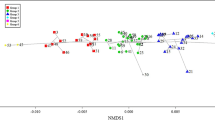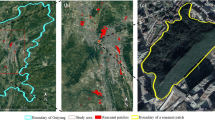Abstract
Urban forest is considered as the most important component of urban green infrastructure and can make vital contributions to urban biodiversity. Understanding the species composition and diversity of urban forest is important for urban biodiversity enrichment. In this study, we evaluated the urban forest woody plant diversity and spatial pattern in Changchun, northeast China. The differentiations in species composition and diversity among types of urban forests and gradients of urbanization were then explored. Principal Component Analysis (PCA) was performed to characterize the species distribution. Similarity Percentage (SIMPER) analysis was adopted to determine the species differentiation and the main contributed species among different urban forest types and different urbanization gradients. The results showed that urban forest species in Changchun were abundant with 88 species that belonged to 50 genera and 24 families. The three major species were Salix matsudana, Populus davidiana, and Pinus sylvestris var. mongolica. Native species were preferred in urban forest of Changchun. Significant differentiations in species composition were observed among different types of urban forests. Attached forest (AF) had the highest species richness and biodiversity, whereas production and management forest (PF) had the lowest ones. SIMPER results showed the highest species dissimilarity between AF and PF and lowest species dissimilarity between AF and landscape and relaxation forest (LF). For different urbanization gradients, species richness and diversity in the third ring were the highest and in the first ring were the lowest. SIMPER results showed the lowest species dissimilarity between the third ring and the fourth ring and highest species dissimilarity between the first ring and the fourth ring. Based on the 10/20/30 “rule of thumb”, the diversity must be urgently increased at the species, genus, and family levels for EF and PF. For different urbanization gradients, diversity should be increased at the species level in the first ring and the fifth ring, and should be increased at the family level in the second ring and the fifth ring.






Similar content being viewed by others
References
Andersson E, Colding J (2014) Understanding how built urban form influences biodiversity. Urban For Urban Green 13:221–226. doi:10.1016/j.ufug.2013.11.002
Andersson E, Barthel S, Ahrné K (2007) Measuring social- ecological dynamics behind the generation of ecosystem services. Ecol Appl 17:1267–1278. doi:10.1890/06-1116.1
Aronson MFJ et al (2014) A global analysis of the impacts of urbanization on bird and plant diversity reveals key anthropogenic drivers. Proc R Soc B Biol Sci. doi:10.1098/rspb.2013.3330, 281
Austin MP (2013) Inconsistencies between theory and methodology: a recurrent problem in ordination studies. J Veg Sci 24:251–268. doi:10.1111/j.1654-1103.2012.01467.x
Berger WH, Parker FL (1970) Diversity of planktonic foraminifera in deep-sea sediments. Science 168:1345–1347
Celesti-Grapow L, Pysek P, Jarosik V, Blasi C (2006) Determinants of native and alien species richness in the urban flora of Rome. Divers Distrib 12:490–501. doi:10.1111/j.1366-9516.2006.00282.x
Chow WTL, Roth M (2006) Temporal dynamics of the urban heat island of Singapore. Int J Climatol 26:2243–2260. doi:10.1002/joc.1364
Clarke LW, Jenerette GD, Davila A (2013) The luxury of vegetation and the legacy of tree biodiversity in Los Angeles, CA. Landsc Urban Plan 116:48–59. doi:10.1016/j.landurbplan.2013.04.006
Colding J (2007) ‘Ecological land-use complementation’ for building resilience in urban ecosystems. Landsc Urban Plan 81:46–55. doi:10.1016/j.landurbplan.2006.10.016
Conway TM, Bourne KS (2013) A comparison of neighborhood characteristics related to canopy cover, stem density and species richness in an urban forest. Landsc Urban Plan 113:10–18. doi:10.1016/j.landurbplan.2013.01.005
Ellenberg D, Mueller-Dombois D (1974) Aims and methods of vegetation ecology. Wiley, New York, NY
Goddard MA, Dougill AJ, Benton TG (2010) Scaling up from gardens: biodiversity conservation in urban environments. Trends Ecol Evol 25:90–98. doi:10.1016/j.tree.2009.07.016
Golding J, Gusewell S, Kreft H, Kuzevanov VY, Lehvavirta S, Parmentier I, Pautasso M (2010) Species-richness patterns of the living collections of the world’s botanic gardens: a matter of socio-economics? Ann Bot 105:689–696. doi:10.1093/aob/mcq043
He XY, Liu CF, Chen W, Guan ZJ, Zhao GL (2004) Discussion of urban forest classification. Chin J Ecol 23:175–178
Hope D et al (2003) Socioeconomics drive urban plant diversity. Proc Natl Acad Sci U S A 100:8788–8792. doi:10.1073/pnas.1537557100
Huang X, Huang XJ, Chen C (2009) The characteristic, mechanism and regulation of urban spatial expansion of Changchun. Areal Res Dev 5:015
Inkilainen ENM, McHale MR, Blank GB, James AL, Nikinmaa E (2013) The role of the residential urban forest in regulating through fall: a case study in Raleigh, North Carolina, USA. Landsc Urban Plan 119:91–103. doi:10.1016/j.landurbplan.2013.07.002
Jim CY (2013) Drivers for colonization and sustainable management of tree-dominated stonewall ecosystems. Ecol Eng 57:324–335
Jim CY (2014) Passive warming of indoor space induced by tropical green roof in winter. Energy 68:272–282
Jim CY, Chen S (2008) Assessing natural and cultural determinants of urban forest quality in Nanjing (China). Phys Geogr 29:455–473
Jim CY, Chen WY (2009) Diversity and distribution of landscape trees in the compact Asian city of Taipei. Appl Geogr 29:577–587
Jim CY, Liu HT (2001) Species diversity of three major urban forest types in Guangzhou City, China. For Ecol Manag 146:99–114. doi:10.1016/s0378-1127(00)00449-7
Jim CY, Zhang H (2013) Species diversity and spatial differentiation of old-valuable trees in urban Hong Kong. Urban For Urban Green 12:171–182
Kendal D, Dobbs C, Lohr VI (2014) Global patterns of diversity in the urban forest: is there evidence to support the 10/20/30 rule? Urban For Urban Green 13:411–417. doi:10.1016/j.ufug.2014.04.004
Kenney WA, van Wassenaer PJ, Satel AL (2011) Criteria and indicators for strategic urban forest planning and management. Arboricult Urban For 37:108–117
Kent M, Stevens RA, Zhang L (1999) Urban plant ecology patterns and processes: a case study of the flora of the City of Plymouth, Devon UK. J Biogeogr 26:1281–1298. doi:10.1046/j.1365-2699.1999.00350.x
Li YM, Xiu CL, Wei Y, Sun PJ (2012) Analysis on mechanism and spatial-temporal features of urban sprawl: a case study of Changchun. Econ Geogr 32:59–64
Li XM, Zhou WQ, Ouyang ZY (2013) Relationship between land surface temperature and spatial pattern of green space: what are the effects of spatial resolution? Landsc Urban Plan 114:1–8. doi:10.1016/j.landurbplan.2013.02.005
Liu C, Li X (2012) Carbon storage and sequestration by urban forests in Shenyang, China. Urban For Urban Green 11:121–128
Lososova Z et al (2012) Native and alien floras in urban habitats: a comparison across 32 cities of central Europe. Glob Ecol Biogeogr 21:545–555. doi:10.1111/j.1466-8238.2011.00704.x
Magurran AE (1988) Ecological diversity and its measurement. Princeton University Press, Princeton, NJ
McCune B, Grace JB, Urban DL (2002) Analysis of ecological communities vol 28. MjM software design, Gleneden Beach, OR
McDonald RI, Kareiva P, Formana RTT (2008) The implications of current and future urbanization for global protected areas and biodiversity conservation. Biol Conserv 141:1695–1703. doi:10.1016/j.biocon.2008.04.025
McKinney ML (2006) Urbanization as a major cause of biotic homogenization. Biol Conserv 127:247–260. doi:10.1016/j.biocon.2005.09.005
McKinney M (2008) Effects of urbanization on species richness: a review of plants and animals. Urban Ecosyst 11:161–176. doi:10.1007/s11252-007-0045-4
McPherson EG, Nowak D, Heisler G, Grimmond S, Souch C, Grant R, Rowntree R (1997) Quantifying urban forest structure, function, and value: the Chicago urban forest climate project. Urban Ecosyst 1:49–61. doi:10.1023/A:1014350822458
McPherson EG, Xiao QF, Aguaron E (2013) A new approach to quantify and map carbon stored, sequestered and emissions avoided by urban forests. Landsc Urban Plan 120:70–84. doi:10.1016/j.landurbplan.2013.08.005
Nagendra H, Gopal D (2010) Street trees in Bangalore: density, diversity, composition and distribution. Urban For Urban Green 9:129–137. doi:10.1016/j.ufug.2009.12.005
Niemela J (1999) Ecology and urban planning. Biodivers Conserv 8:119–131. doi:10.1023/a:1008817325994
Nowak DJ, Crane DE, Stevens JC, Hoehn RE (2003) The urban forest effects (UFORE) model: field data collection manual V1b Newtown Square, PA: US Department of Agriculture, Forest Service, Northeastern Research Station
Nowak DJ, Greenfield EJ, Hoehn RE, Lapoint E (2013) Carbon storage and sequestration by trees in urban and community areas of the United States. Environ Pollut 178:229–236. doi:10.1016/j.envpol.2013.03.019
Pielou E (1966) The measurement of diversity in different types of biological collections. J Theor Biol 13:131–144
Ren Z, He X, Zheng H, Zhang D, Yu X, Shen G, Guo R (2013) Estimation of the relationship between urban park characteristics and park cool island intensity by remote sensing data and field measurement. Forests 4:868–886
Ricketts T, Imhoff M (2003) Biodiversity, urban areas, and agriculture: locating priority ecoregions for conservation. Ecol Soc 8:1
Santamour, FS (1990) Trees for urban planting: diversity, uniformity, and common sense. In: Proceedings of the seventh conference of the metropolitan tree improvement alliance (METRIA), pp. 57–65
Savard JPL, Clergeau P, Mennechez G (2000) Biodiversity concepts and urban ecosystems. Landsc Urban Plan 48:131–142. doi:10.1016/s0169-2046(00)00037-2
Schmidt KJ, Poppendieck HH, Jensen K (2014) Effects of urban structure on plant species richness in a large European city. Urban Ecosyst 17:427–444. doi:10.1007/s11252-013-0319-y
Seburanga JL, Kaplin BA, Zhang QX, Gatesire T (2014) Amenity trees and green space structure in urban settlements of Kigali, Rwanda. Urban For Urban Green 13:84–93. doi:10.1016/j.ufug.2013.08.001
Seto KC, Guneralp B, Hutyra LR (2012) Global forecasts of urban expansion to 2030 and direct impacts on biodiversity and carbon pools. Proc Natl Acad Sci U S A 109:16083–16088. doi:10.1073/pnas.1211658109
Shannon EC, Weaver W (1963) The mathematical theory of communication. University of Illinois Press, Urbana, IL
Sjoman H, Ostberg J, Buhler O (2012) Diversity and distribution of the urban tree population in ten major Nordic cities. Urban For Urban Green 11:31–39. doi:10.1016/j.ufug.2011.09.004
Thaiutsa B, Puangchit L, Kjelgren R, Arunpraparut W (2008) Urban green space, street tree and heritage large tree assessment in Bangkok, Thailand. Urban For Urban Green 7:219–229. doi:10.1016/j.ufug.2008.03.002
Thompson K, Austin KC, Smith RM, Warren PH, Angold PG, Gaston KJ (2003) Urban domestic gardens (I): putting small-scale plant diversity in context. J Veg Sci 14:71–78. doi:10.1111/j.1654-1103.2003.tb02129.x
Vakhlamova T, Rusterholz H-P, Kanibolotskaya Y, Baur B (2014) Changes in plant diversity along an urban–rural gradient in an expanding city in Kazakhstan, Western Siberia. Landsc Urban Plan 132:111–120. doi:10.1016/j.landurbplan.2014.08.014
Wania A, Kuhn I, Klotz S (2006) Plant richness patterns in agricultural and urban landscapes in Central Germany - spatial gradients of species richness. Landsc Urban Plan 75:97–110. doi:10.1016/j.landurbanplan.2004.12.006
Xiao QF, McPherson EG (2011) Rainfall interception of three trees in Oakland, California. Urban Ecosyst 14:755–769. doi:10.1007/s11252-011-0192-5
Yang J, McBride J, Zhou J, Sun Z (2005) The urban forest in Beijing and its role in air pollution reduction. Urban For Urban Green 3:65–78
Zerbe S, Maurer U, Schmitz S, Sukopp H (2003) Biodiversity in Berlin and its potential for nature conservation. Landsc Urban Plan 62:139–148. doi:10.1016/S0169-2046(02)00145-7
Zhang H, Jim CY (2014a) Contributions of landscape trees in public housing estates to urban biodiversity in Hong Kong. Urban For Urban Green 13(2):272–284. doi:10.1016/j.ufug.2013.12.009
Zhang H, Jim CY (2014b) Species diversity and performance assessment of trees in domestic gardens. Landsc Urban Plan 128:23–34. doi:10.1016/j.landurbplan.2014.04.017
Zhang BA, Xie GD, Zhang CQ, Zhang J (2012) The economic benefits of rainwater-runoff reduction by urban green spaces: a case study in Beijing, China. J Environ Manag 100:65–71. doi:10.1016/j.jenvman.2012.01.015
Acknowledgments
We are thankful for the help from Chao Gong in editing and correcting the manuscript, as well as the help from Bin Zhang and Zhilei Liu in the data analysis. This work is supported by the CAS/SAFEA International Partnership Program for Creative Research Teams (KZZD-EW-TZ-07-09) and the Excellent Young Scholars of Northeast Institute of Geography and Agroecology at the Chinese Academy of Sciences (DLSYQ13004). We also thank the anonymous reviewers for helpful comments that have improved our manuscript.
Conflict of interests
The authors declare no conflict of interest.
Author information
Authors and Affiliations
Corresponding author
Appendix
Appendix
Rights and permissions
About this article
Cite this article
Zhang, D., Zheng, H., He, X. et al. Effects of forest type and urbanization on species composition and diversity of urban forest in Changchun, Northeast China. Urban Ecosyst 19, 455–473 (2016). https://doi.org/10.1007/s11252-015-0473-5
Published:
Issue Date:
DOI: https://doi.org/10.1007/s11252-015-0473-5




